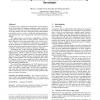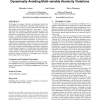72 search results - page 3 / 15 » Debugging programs that use atomic blocks and transactional ... |
POPL
2009
ACM
14 years 8 months ago
2009
ACM
Speed improvements in today's processors have largely been delivered in the form of multiple cores, increasing the importance of ions that ease parallel programming. Software...
CAV
2009
Springer
14 years 7 months ago
2009
Springer
Abstract. Pseudo-code descriptions of STMs assume sequentially consistent program execution and atomicity of high-level STM operations like read, write, and commit. These assumptio...
ASPLOS
2006
ACM
14 years 1 months ago
2006
ACM
Concurrency bugs are among the most difficult to test and diagnose of all software bugs. The multicore technology trend worsens this problem. Most previous concurrency bug detect...
ISCA
2010
IEEE
14 years 13 days ago
2010
IEEE
In this paper, we propose ColorSafe, an architecture that detects and dynamically avoids single- and multi-variable atomicity violation bugs. The key idea is to group related data...
ISCA
2008
IEEE
14 years 1 months ago
2008
IEEE
Writing shared-memory parallel programs is error-prone. Among the concurrency errors that programmers often face are atomicity violations, which are especially challenging. They h...


